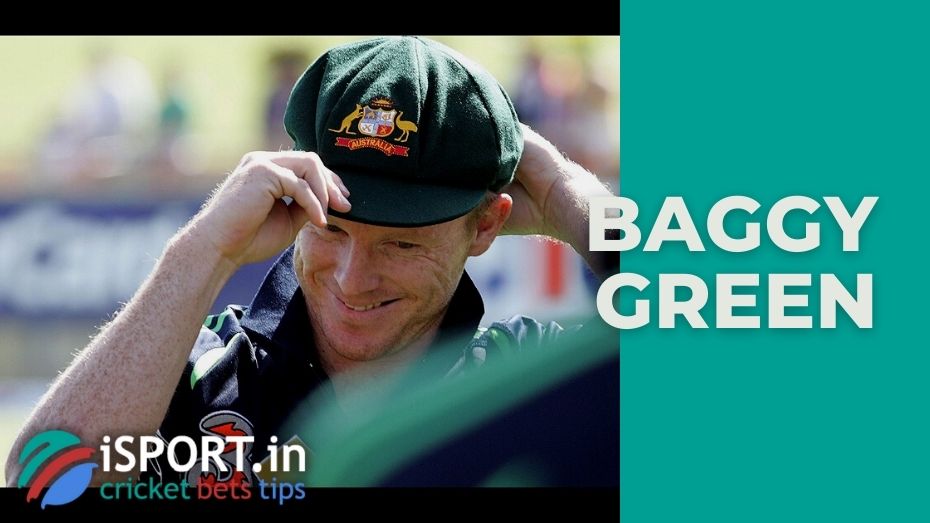Baggy green

The Australian national cricket team is one of the world’s leading sides, both in the men’s and women’s game.
Australia was one of the founding members of the International Cricket Council, so it’s no surprise that the representatives of the Green Continent have developed their own unique traditions. One of the most iconic is the baggy green — a cricket cap made from dark myrtle green fabric.
Baggy Green: A Brief History
Australians started wearing a cap at the beginning of the 20th century. At the same time, at first, it was not baggy. You can see this if you look at the photos of those times. This cap has become so popular with the Australian national cricket team that the Marylebone Cricket Club recognized it as the “most famous cricket cap in the world”. In the 20th century, this headdress was considered a national pride.
In the 1990s, the cap’s shape started to change, becoming increasingly baggy. This was largely influenced by team captains Mark Taylor and Steve Waugh. Waugh, in particular, believed the baggy green symbolized the team’s success, and he considered it essential to the Australian cricket identity. He also thought the cap should be more noticeable — hence, bigger. Thanks to his influence, many players began and ended their careers wearing the same cap, which was not the tradition before.
- In the early and mid-20th century, players received a new cap with their uniform at the start of each season, often marked with the year.
- Since the 1990s, under Waugh’s leadership, players have typically worn a single cap for their entire international career. Over the years, this led to visibly faded and worn baggy greens, instantly identifying veterans on the field.
- At the beginning of the 21st century, the Australians began to award baggy green to the team’s newcomers. After some time, it was decided that the caps would be inherited from the players by position. For example, bowler No. 1 finished his career in the national team. In his place came bowler No. 2, and it is he who gets the headdress.
- A little later, players from Australia could wear baggy green at will. At the same time, the tradition was maintained that everyone wore caps for the first session of the match. Then any player could remove the headdress. This tradition was observed even by Shane Warne, who liked to wear soft hats.
Today, Australian cricketers wear the baggy green by choice. While some veteran players still don the famous cap, most — particularly batters — now wear helmets during matches.
Baggy Green: The Emblem
The emblem on the baggy green reflects the symbol of the national federation at the time the cap was introduced. At that time, Australians were proud of their success in wool cultivation, agriculture, shipping, and mining. The coat of arms consists of the following elements:
- A crest (a rising sun),
- Placed over a torse (wreath) of red and gold,
- Above a shield divided by the Southern Cross, featuring a golden fleece, sailing ship, pickaxe and shovel, and a sheaf of wheat,
- Flanked by supporters — a kangaroo and an emu,
- All above a scroll bearing the motto “Australia.”
There are slight differences between the men’s and women’s caps:
- On the men’s version, the motto appears in green letters on a red background.
- On the women’s version, it’s reversed — red letters on a green background.
Note that the coat of arms is different from any version of Australia’s national coat of arms. In the coat of arms of Australia, the main element is the badges of the country’s six states.
Baggy Green: Interesting Facts
There are several interesting facts associated with baggy green:
- At one time, famous Australian cricketers wore baggy greens not only on the field, but also outside it. So thanks to them, baggy green became even more popular. Bill Lawry cleaned his household in this headdress (he kept pigeons). Bill Ponsford was seen wearing a cap when he was painting a fence.
- The cap has become a collector’s item at auctions:
- Sir Donald Bradman’s cap from his final season in 1948 sold in 2003 for A$425,000.
- Keith Miller’s 1953 cap fetched A$35,000 at the same event.
- In 2020, Shane Warne’s cap was bought by the Commonwealth Bank for A$1,007,500, with all proceeds going to support Australia’s emergency services following the devastating bushfires of 2019–2020.
Even caps worn by less famous players have fetched A$10,000 or more at auction — proof of the baggy green’s place as a national treasure.
